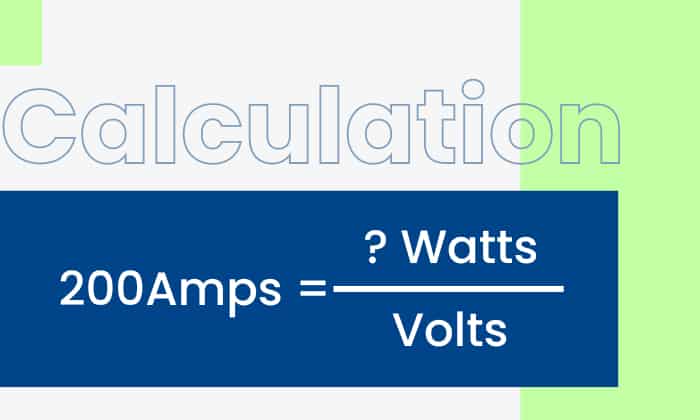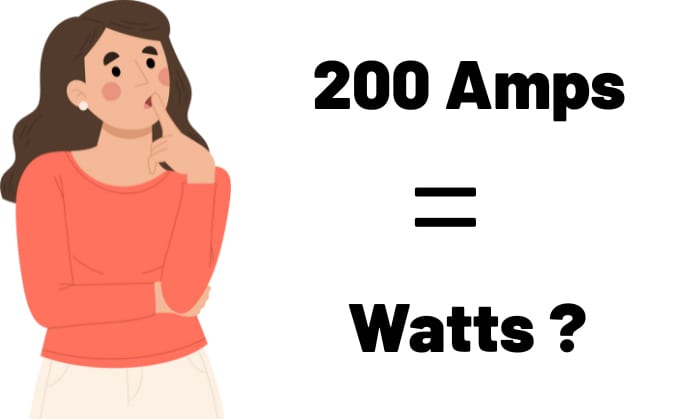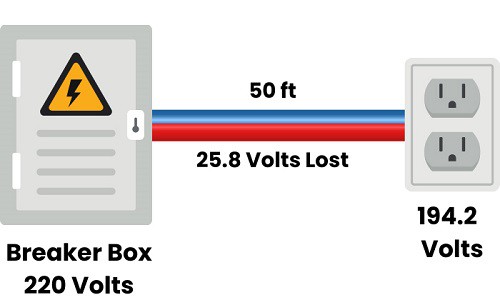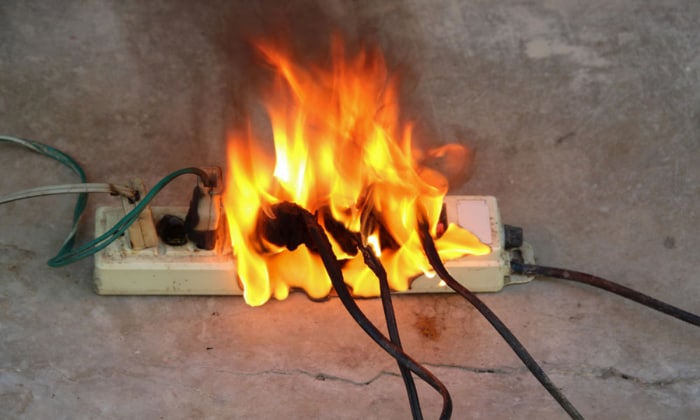Perhaps you’re wiring a 200-amp service panel for your property. Now, you’re wondering how many watts is 200 amps?
200 amps can support up to 48,000 watts if the voltage used for the assembly is 120 volts. Note that this wattage rating may differ depending on the current type and voltage drop.
In this post, you’ll learn how to convert 200 amps to watts while looking at different factors. You’ll also gain insight into what happens if you exceed the wattage as you read this post.
Table of Contents
Calculating Watts From 200 Amps
As mentioned earlier, one of the factors to determine 200-amp equals how many watts depends on the current type and voltage drop. Learn about the different formulas to use below:
1. Current Type
Generally, there are two main current types: Direct Current (DC) and Alternating Current (AC). AC has two sub-types: single-phase and three-phase. Also, Three-phase AC also has its types, depending on the voltage: line-to-line and line-to-neutral.
Amps-to-Watts Conversion for DC
Electronic devices using DC have currents that always flow the same. The formula to convert 200 amps to watts using DC is the following:
\[ \text{Watts} = \text{Amps} \times \text{Volts} \]
For example, assuming that you’re using a 12V appliance. If so, the calculations are the following:
\[ \text{Watts} = 200\, \text{amps} \times 12\, \text{volts} = 2,400\, \text{watts} \]
Amps-to-Watts Conversion for Single-Phase AC
AC, generally, has a flow of electricity that changes direction and value. Use the following formula to find the wattage of a 200-amp single-phase AC device:
\[ \text{Watts} = \text{Amps} \times \text{Power Factor} \times \text{Volts} \]
Assuming that the power factor is 1 at 240V, your calculations should look like the following:
\[ \text{Watts} = 200\, \text{amps} \times 1 \times 240\, \text{volts} = 48,000\, \text{watts} \]
Amps-to-Watts Conversion for Three-Phase AC Line-to-Line Voltage
AC using line-to-line voltage differs since it’s typically higher than a line-to-neutral voltage, particularly in a star connection. Use the following formula to convert 200 amps to watts if the circuit is using this three-phase AC setup:
\[ \text{Watts} = \text{Amps} \times \sqrt{3} \times \text{Power Factor} \times \text{Voltage} \]
Again, assuming your power factor is 1 and the circuit is at 120v, the calculations look like the following:
\[ \text{Watts} = 200\, \text{amps} \times \sqrt{3} \times 1 \times 120\, \text{volts} = 41,569.22\, \text{watts} \]
Amps-to-Watts Conversion for Three-Phase AC Line-to-Neutral Voltage
As for AC using line-to-neutral voltage, this circuit is typically lesser than its line-to-line counterpart. If your connection is using this type of three-phase circuit, use the formula below:
\[ \text{Watts} = \text{Amps} \times 3 \times \text{Power Factor} \times \text{Voltage} \]
Using the same values as the example in the line-to-line voltage calculations, the formula to convert amp to watts for a three-phase line-to-neutral voltage is the following:
\[ \text{Watts} = 200\, \text{amps} \times 3 \times 1 \times 120\, \text{volts} = 72,000\, \text{watts} \]
2. Voltage Drop
Aside from the different current types, you must also pay attention to the voltage drop of the circuit to determine the correct wattage rating. The National Electrical Code (NEC) recommends that the voltage drop be no larger than 3% to 5%.
In particular, the maximum voltage drop for both the branch and feeder circuits is 5%. So, the maximum voltage drop for the branch or feeder circuit is 3%.
Calculate the voltage drop by looking at the current type. The formulas to use based on that factor are the following:
- Single-phase: (2 x Conductor’s impedance x Current in amps x Wire length) / 1,000
- Three-phase: (1.73 x Conductor’s impedance x Current in amps x Wire length) / 1,000
For example, you’re using a 200-amp single-phase appliance at 220 volts; assuming that the conductor’s impedance is 1.29 ohms for every 1,000 feet and the wire’s length is 50 feet, the calculations look like the following:
\[ \text{Voltage drop} = \frac{2 \cdot 1.29 \, \text{ohm/kft} \cdot 200 \, \text{amps} \cdot 50 \, \text{feet}}{1,000} = 25.8 \, \text{volts} \]
\[ \text{Percentage voltage drop} = \frac{2.84\, \text{volts}}{220\, \text{volts}} = 11.73\% \]
Also, here’s a 200 amps-to-watts conversion chart based on the various current types:
| Voltage | DC | Single-Phase AC | Single-Phase AC (Line-to-Line Voltage) | Single-Phase AC (Line-to-Neutral Voltage) |
| 12 | 2,400 watts | 2,400 watts | 4,156.92 watts | 7,200 watts |
| 110 | 22,000 watts | 22,000 watts | 38,105.12 watts | 66,000 watts |
| 120 | 24,000 watts | 24,000 watts | 41,569.22 watts | 72,000 watts |
| 220 | 44,000 watts | 44,000 watts | 76,210.24 watts | 132,000 watts |
| 240 | 48,000 watts | 48,000 watts | 83,138.44 watts | 144,000 watts |
Note: The power factor used to find the values for the wattage in AC is 1.
What Happens if You Exceed the Wattage of Your Circuit?
Problems typically appear if you exceed the wattage of a circuit. For instance, the connected device may overheat or damage the wiring. If left alone, these problems may even aggravate, leading to bigger concerns like house fires.
Here are some examples of appliances that pull the most wattage to help you keep a close eye on your property’s energy usage:
- Heating and cooling equipment
- Water heater
- Lighting
- Refrigerator
- Washer and dryer
Conclusion
Remember, you should pay attention to various elements before determining how many watts is 200 amps. For instance, verifying the current type allows you to use the correct formula.
Failure to use the right calculations can lead to incorrect power usage. If you exceed the wattage of the circuit, it can result in problems like the circuit’s destruction. It may also lead to more grievous concerns, such as house fires.

I am Edwin Jones, in charge of designing content for Galvinpower. I aspire to use my experiences in marketing to create reliable and necessary information to help our readers. It has been fun to work with Andrew and apply his incredible knowledge to our content.





